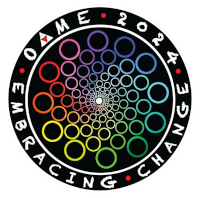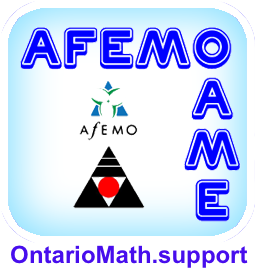President's Message - September 2023
Mathematics The Game Changer

SANDRA JEAN PRICE
sandra.jean.price@oame.on.ca
In June, NCTM president, Kevin Dykema, included in his president’s message a discussion regarding what mathematics is. He cited the growing debate on social media that is, at best, an open and honest discourse, but at times is divisive, abusive, and marginalizing. But as he pointed out, it all stems from how one defines mathematics. He stated, “Because mathematics must be about reasoning and sense making, it should be taught and learned differently than if mathematics were only about getting answers” (Dykema, 2023). This distinction is very important. Procedural fluency, the ability to get the correct answer quickly, using an algorithm, is not necessarily mathematical proficiency. Proficiency truly means that a person can understand a concept and how it fits within other mathematical concepts. It is not just memorizing a formula and being able to apply it.
Thinking back to my days as a student, I had some incredible math teachers who helped me understand the concepts. But at the end of the day, I had a really good memory and could just memorize what I needed to do. I was very adept at applying procedures. But, for example, why did a negative integer multiplied by a negative integer result in a positive integer? I couldn’t have told you or done anything to prove that thinking. I just knew that it was a “rule.” It wasn’t until I was a teacher that I started asking and being able to answer the “why” questions that I had always had, but was afraid to ask. Consequently, as a teacher, I have always strived to teach beyond the rules and procedures and allow students to understand the concepts, which eventually leads to their ability to apply the same mathematical procedures, but with a conceptual understanding of how and why the procedures work within the world of mathematics. This is the main difference between knowledge and understanding. By having a strong conceptual understanding of an algorithm or procedure that goes beyond memorization, a student is able to apply that understanding in a variety of different contexts.
Mathematics can be a game changer for many students. In the past, if a student struggled to be successful in math, often they were told that they just aren’t good at math. In my second President’s Message, I related my own experience with this and how it affected my feelings of self-worth and my self-efficacy in other areas. Mathematics can also be a positive influence on individuals, allowing students to make sense of the world around them through, for example, understanding data graphics, to be better able to think critically about the data and differentiate that from how the data is being presented. Feeling capable and being successful often breeds more success. To that end, educators have an obligation to use their expertise in pedagogy to help and give all students the opportunity to be successful in mathematics.
To do this, however, it is necessary to understand how math and its applications have perhaps helped to marginalize specific populations in the past. The most obvious way is through the IQ test. While the original IQ test was created by Alfred Binet in 1904 to help identify students who would be most likely to require extra help to be successful in school, the use of the modified Stanford-Binet IQ test in the immigration process in the United States in the 1940’s led to generalizations about entire populations (Cherry, 2023). In fact, low test scores, or low IQ’s, were used by eugenicists to try to convince the U.S. Congress to restrict immigration of those who they felt were genetically inferior into the U.S. What was originally intended to be a helpful tool to address the needs of students was altered and then applied in an entirely different context to support a very narrow and biased agenda. The misinformation that grew out of this movement continues today.
Another example is our very Eurocentric mathematics system. The Indigenous peoples in Canada have long had their own mathematics systems in place, very much rooted in culture, in their relationships with each other and the land, and in the world. Over the last 20 years, mathematics education has begun to recognize that many of the research- proven pedagogical strategies align with how Indigenous groups in Canada view and learn math. Outside of Canada, it is interesting that we have learned that the Pythagorean relationship was actually discovered by many others. In fact, there is concrete evidence that Babylonians had some knowledge of this. There are four tablets from around 1900– 1600 BCE that show calculations of the square root of 2, which is the length of the hypotenuse of a right triangle, with the length of the legs being 1 unit. It also lists what we know as Pythagorean triples that satisfy this relationship. The theorem is mentioned in other cultures around the world including, but not limited to, India in the Baudhayana Sulba- sutra, which was written between 800 and 400 BCE. It appears that this relationship was discovered by many different cultures over a span of time. This is something that I was never aware of as a student. It was never discussed.
I identify as a White cisgender female who, although born in Canada, is a settler. I am not a person of colour, nor do I identify as being Indigenous, despite having some Indigenous ancestry. And I do not consider myself an expert in how systemic oppression has impacted our youth from underserved and marginalized communities. But I am a teacher and believe every student has a right to learn, experience, and be successful in mathematics. If this means that time needs to be invested in exploring the context and history of bias within math, then it is time well spent. To clarify, the math itself isn’t racist. What we choose to define as math, what we choose to teach as math, who has been included and identified as mathematicians, and how we do the teaching is where we see racism and Eurocentric bias. And if there are some people out there who argue that math has nothing to do with racism and that these discussions should not take place within a math classroom, then it is important to remember that for years, there were many other things that were not discussed in any classes. Colonization and its impact on our Indigenous communities was not discussed until relatively recently. Just because it wasn’t discussed does not mean that the atrocities that we have learned about did not happen. They did. We just weren’t ready to listen. It would be naïve to believe that mathematics has only been used to promote justice and equity. However, believing teachers can teach mathematics while promoting justice and equity is not naïve; it is what educators should be aspiring to.
Previous Message:
“As we look ahead into the next century, leaders will be those who empower others.” ~ Bill Gates
Next Message:
President Message


















 Like us on FaceBook
Like us on FaceBook